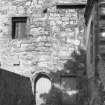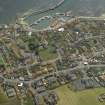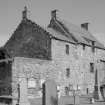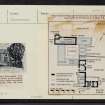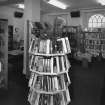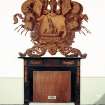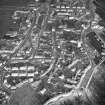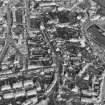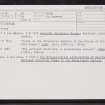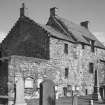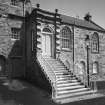Pittenweem, Marygate, Pittenweem Priory
Priory (13th Century)
Site Name Pittenweem, Marygate, Pittenweem Priory
Classification Priory (13th Century)
Alternative Name(s) Town Hall; Great House; Prior's Lodging; St John's Rectory
Canmore ID 34240
Site Number NO50SW 5
NGR NO 54956 02573
Datum OSGB36 - NGR
Permalink http://canmore.org.uk/site/34240
- Council Fife
- Parish Pittenweem
- Former Region Fife
- Former District North East Fife
- Former County Fife
NO50SW 5.00 54956 02573
NO50SW 5.01 54974 02602 Gatehouse
NO50SW 5.02 54912 02601 Parish Church
NO50SW 5.03 549 026 Priory Walls
NO50SW 5.04 54930 02618 Church Yard
See also:
NO50SW 464 5492 0267 Proposed new Town Hall
(NO 5495 0257) Priory (NR)
OS 1:10000 map (1973)
The remains of Pittenweem Priory surrounding the Inner Close are:
(a) the 3-storeyed W range, known as the Great House. This was built in the 15th century (SDD List 1962), and was the part where the monks and their servants lived. It was secularised late in the 16th century, and part rebuilt as the Town Hall in 1821. The remainder, to the N, has been recently restored as houses for two clerical families (H Fenwick 1970). (b) A 3-storeyed S range, the Prior's Lodge, of 16th century date, later restored as a rectory, and
(c) the N wall, mostly of 17th century date. See NO50SW 5.01 - 5.03). The lands of Pittenweem were granted to the monks of May (see NT69NE 1) by David I c.1142. While it is commonly assumed that this priory was established through the transference to Pittenweem of the community in the Isle of May during the late 13th or early 14th century, i.e. in the period within which the priory of May passed from the possession of the Benedictine Abbey of Reading into the possession of the Augustinian Priory of St Andrews, it is impossible to trace the precise course of events or to assign it a specific date. The available evidence presents and abundance of problems and discrepancies. The monastic buildings were granted to the burgh of Pittenweem by James VI in 1593.
RCAHMS 1933; D E Easson 1957
The Prior's Lodge and the Great House are now private residences and are as described. (See NO50SW 5.03 for precinct wall.)
Visited by OS (DWR) 30 May 1974
The south end was rebuilt in 1821 as Pittenweem Town Hall
Non-Guardianship Sites Plan Collection, DC28437- DC28440, 1954.
Field Visit (30 June 1927)
Pittenweem Priory.
This house of Augustinian or Austin Canons stood on the raised beach overlooking the harbour, near the site of the present parish church, which may partly overlie the foundations of the monastic church. All that can be identified with certainty as part of the conventual buildings is the gatehouse (SC 1108719), but the enclosure into which it opened, evidently the cloister, is bounded on west (SC 1108717) and south by buildings which date in part from the 15th century.
The gatehouse faces north-east. It is built of coursed rubble, with pinnings, and is two storeys in height. In the lower part is a central archway, above which, near the wall-head, is an empty panel-space, flanked at a lower level by two small windows checked for outer shutters. The wall-head bears a parapet-walk projecting on heavy machicolated corbels of two members and circled at the eastern angles to carry ‘rounds’. The style of the corbels suggests a 15th-century date. There has also been a parapet on the inner side of the wall, and the access to its walk was by a stair on the north gable. The roof of the upper storey must therefore have been of the lean-to variety. The central archway opens into a transe, on either side of, which is a chamber, the northern one partly vaulted.
The range of buildings on the south is three storeyed and may have been heightened. It has been considerably modernised, but the lowest storey, which consists of three cellars and a pend, all vaulted, was in existence in the late 16th century, and is probably of earlier date.
The western range of buildings is pierced by a central transe. It was almost entirely rebuilt in the 16th century, with an alteration of the original levels, and there was further rebuilding in the 17th. The only surviving details referable to the earliest period are a fireplace and around-headed doorway in the west wall. Except at the north gable, against which there has been a two-storeyed pent-house, the structure is mainly three-storeyed. The masonry is rubble, probably at one time harled. The east wall has two oriel windows and a slight circled projection at a turnpike. The broad northern crow-steps of the centre part date from the 16th century. On the west wall, at first-floor level, there has been a balcony on the centre part of the range, part of its weather-table, access, and corbels being still traceable. No part of the range is vaulted.
On the north there has been another range of buildings. To judge by the openings that can now be traced, these are not earlier than the17th century.
An armorial panel of the 15th century has been inserted into the west wall of the Episcopalian Church, which adjoins the property. The shield is ensigned with a mitre supported by angel figures, and it bears: A chevron between three cross-crosslets fitchy within a double tressure flory-counter-flory, for James Kennedy, Bishop of St . Andrews, who died in 1465. On a scroll below the shield is a now illegible motto. The same coat is repeated on the shield built upside down into the south gable of the Town Hall, which was erected in 1821 on the site of an earlier building at the south end of the present west range. In the north wall of the chancel of the Episcopal church is an armorial stone ensigned with a mitre and bearing: Quarterly, Ist and 4th, a chevron engrailed between three; 2nd and 3rd an eagle's (?) head erased and collared.
CARVED PANELS. In one of the cellars of the south range were found six carved panels oak, which appear to have been the door of a cabinet in the Priory. Each bears a head threemale and three female-within a medallion, the rest of the surface being ornamented with strap-work and foliaceous designs, Renaissance in character. One head wears a crown and is surmounted by a wreath. This may be intended for James V (1513-1542), as the work dates from about his time. The panels are now in the National Museum and are figured in Archaeologia Scotica, III, pl. xi, fig. i; d. p.309.
HISTORICAL NOTE. Pittenweem ("Petneweme") was conferred by David I on the church and "brethren" of the May (1). After the dissociation of the Priory of the May from Reading (see No. 39), the comparatively superior attractions of Pittenweem over the island brought about the transference of the convent to the mainland town. Thereafter the foundation becomes "the monastery of Pittenweem alias of the Isle of May" (2), or “the priory of the May and Pittenweem” (3). In a charter of 1540/1 it is described as a place "of small importance and dependent on the honest toil (virtuosis laboribus) of the poor fishermen inhabiting the burgh and barony of Pittenweem" (4). Thirty-two years after the Reformation part at least of the conventual buildings became the property of the burgh. The buildings specified are the "greit hous . . . contenand the channonis or monkis frater and dortor ... with the cellaris beneth and loftis abone the samyn frater and dortor ... the westries of the said monasterie vnder and abone ... the chaptour chalmer ...and cellair beneth the said chalmer," all lying "on the wast pairt of the inner clois of the said monasterie betuix the samyn clois on the east, the new galrie at the eist end of the hall of the said monasterie on the south, the commoun gait[road], kirk yaird and houses, &c., on the wast and the wast gardin of the said monasterie on the north partis". The character of the frater and dorter as three-storeyed buildings and their position, as well as that of the chapter-house, in the west range of the cloister, are unusual. The buildings were to be used for the erection of a minister's manse, grammar-school, tolbooth, prison, weigh-house, custom-house, &c (5). Cf. also Introd., p. xlviii.
RCAHMS 1933, visited 30 June 1927.
(1) Records of the Priory of the Isle of May, p. 3. (2) Reg. Mag. Sig., s.a., 1526, No. 388. (3) Ibid., s.a., 1540/1, No. 2292. (4) Ibid. (5) Acts Parl. Scot., iii, p. 552.
Publication Account (1981)
The lands of Pittenweem were granted to the monks of the Isle of May, c.1143, and thus began a centuries-long relationship which eventually led to the transference of. the priory from the Isle of Pittenweem itself. Reasons for this transference and when it came about are almost impossible to trace. Although the priory had been granted to the priory of Reading, it was transferred to St.Andrews in the period of the Wars of Independence. (In this period it appears that the term priory of May is being used interchangeably with priory of Pittenweem). On the 30 January 1549/50, the prior of Pittenweem was granted a lease of the Isle of May, which was said to have been lying waste (Cowan and Easson, 1976, 60).
The Augustinian priory of Pittenweem stood on a raised beach overlooking the east haven and standing near the site of the present parish church, which may partly overlie the foundations of the monastic church (RCAM, 1933, 222). The buildings of the priory were supposed to have formed a quadrangle. On the east was the gateway with porter's lodge, while on the south side stood the prier's hall and adjoining it, the new gallery. The Town Hall on the west occupies the site of the frater or refectory and adjoining• it was the dormitory and other buildings, including a chapel and vestries. Portions of these buildings survive and had been occupied as a minister's manse, Episcopal Meeting House, a dwelling house and latterly as a barrel store (Conolly, 1869, 211-212). Recently they have been restored as houses for two clerical families (Ordnance Survey Record Cards, Reference NO 50 SW 5.1). The church of the priory is alleged to have stood on the north side of the quadrangle. In 1592, James VI granted part of the conventual buildings to the burgh. They were specified as the:
‘greit hous...contenand the channories or monks frater
and dertor ...with the cellaries beneth and loftis abone
the samyn frater and dorter...the vestries of the said
monasteries under the abone ...the chap tour chalmer...
and cellair beneth the said chalmer' (all lying) 'on
the west pairt of the inner clois of the said monasterie,
betuix the samyn clois on the east, the galrie at the
east end of the hall of the said menasterie on the south,
the commoun gait (road), kirk yaird and houses and etc.
on the wast and the wast gardin of the said monasterie
on the north partis' (RCAM, 1933, 224).
Shortly this gift was turned into a grammar school, minister's manse, tolbooth, prison, weigh-house and custom house for the burgh.
Information from ‘Historic Pittenweem: The Archaeological Implications of Development’ (1981).
Publication Account (1996)
The town hall of 1821-2 is two-storeyed and rectangular on plan, measuring some 13.7m across its main (SW) front by 7.9m in width. It incorporates elements of its predecessor and of the priory buildings. The rear (NE) wall, which is a survival of the refectory and continuous with the 'Great House' to the NW, includes an oriel-window with moulded surround. The other two larger windows in this wall appear to have been inserted, but a small low-level opening at the NW end may be original. The SE gable may also incorporate masonry from the earlier tolbooth, which rose to the same height as the 'Great House' and had a crow-stepped SE gable.
The SW front, which is set forward from the line of its predecessor, is constructed of roughly-coursed' ashlar, with polished and raised quoins and margins. Access to the ground floor is by a round-headed doorway set NW of centre, and the first floor is reached by an original forestair, with late 19th century iron balusters and porch, at the NW end of the front. The windows are round-headed and, with the exception of a small ground-floor window, have intersecting curved glazing bars Built upside-down into the top of the SE gable there is a re-used armorial panel bearing the arms of James Kennedy, Bishop of St Andrews (d.1465).
Internally, the ground floor has been extensively modernised in the 1960s and 1970s and it possesses few notable features. About half of its area, probably to the NW, was occupied by a criminal cell and two debtors' rooms until 1847 when it was converted to police accommodation. The first floor appears to be largely unaltered from its construction in the 1820s. At the NW gable there is a landing which retains a remarkable Regency chimney piece, whose stone surround encloses a castiron inset having Egyptian 'mummy' figures to each side, surmounted by lion-heads set in roundels within projecting squares; along the lintel of this inset there is a design incorporating fasces and twin-headed axes.
The former council-room, which was also used for courts, is lit by two large windows in the SW front. It has a coombed ceiling and at the NW end there is a small 'orchestra or music gallery' with turned wooden balusters, set above a curved recess and below a slightly-pointed barrel-vault. A large timber chirnneyiece in the SE wall has been painted with nautical motifs including a figure of Neptune in the central panel. Painted in grisaille above this chirnneypiece there is a very elaborate version of the burgh arms, incorporating thistles and the royal arms of Scotland. A small version of the burgh arms above a thistle-and-rose border is painted in colour in the central panel of the gallery. The ceiling has a central rose comprising long radiating acanthus-leaves framed with crossed sprigs. There are doors in each corner of the end walls of the room, and these and the shutters have fielded panels of Regency type. The roof-structure, which has been partly renewed, is of collar-rafter form, but with an A-frame employed every sixth beam, marked by raised tie-beams.
HISTORY
A petition by local residents in June 1821 protested that the condition of the town-house rendered it dangerous to neighbouring property and to passers-by. One of the petitioners, James Horsburgh, was asked to prepare a plan and elevation for a new building, observing 'the utmost economy', and an estimate of £205 by David Brown, mason in Pittenweem, was accepted. The specification required as much as possible of the old materials to be re-used, and the two large windows in the new council-room were to be similar in size and shape to the old ones, so that the existing frames could be used. Other timberwork and a fireplace-surround from the old council-room were to be used in the debtors' rooms. The work was completed in March 1822.
Information from ‘Tolbooths and Town-Houses: Civic Architecture in Scotland to 1833’ (1996).


























































































